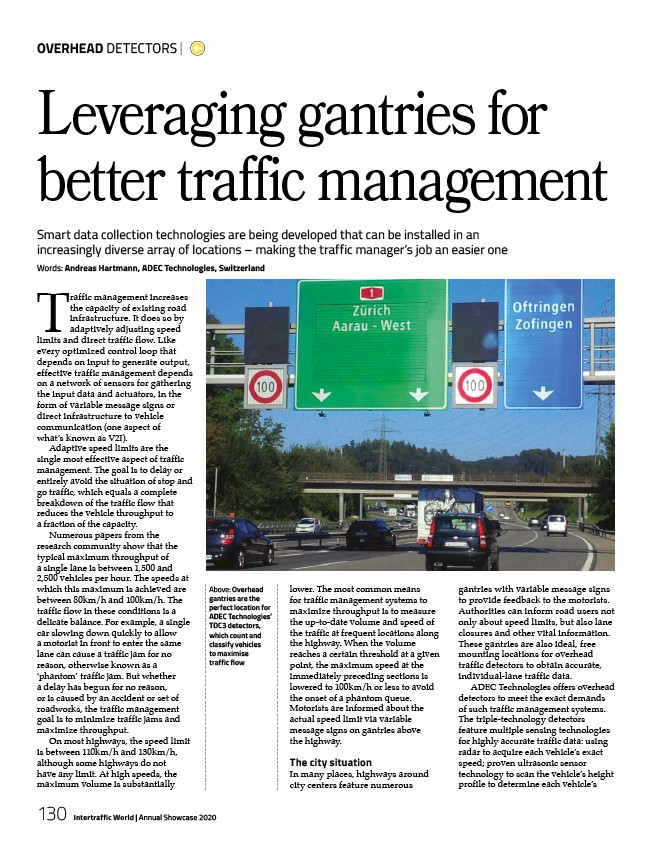
OVERHEAD DETECTORS |
Leveraging gantries for
better traffic management
Smart data collection technologies are being developed that can be installed in an
increasingly diverse array of locations – making the traffic manager’s job an easier one
Words: Andreas Hartmann, ADEC Technologies, Switzerland
Above: Overhead
gantries are the
perfect location for
ADEC Technologies’
TDC3 detectors,
which count and
classify vehicles
to maximise
traffic flow
Traffic management increases
the capacity of existing road
infrastructure. It does so by
adaptively adjusting speed
limits and direct traffic flow. Like
every optimized control loop that
depends on input to generate output,
effective traffic management depends
on a network of sensors for gathering
the input data and actuators, in the
form of variable message signs or
direct infrastructure to vehicle
communication (one aspect of
what’s known as V2I).
Adaptive speed limits are the
single most effective aspect of traffic
management. The goal is to delay or
entirely avoid the situation of stop and
go traffic, which equals a complete
breakdown of the traffic flow that
reduces the vehicle throughput to
a fraction of the capacity.
Numerous papers from the
research community show that the
typical maximum throughput of
a single lane is between 1,500 and
2,500 vehicles per hour. The speeds at
which this maximum is achieved are
between 80km/h and 100km/h. The
traffic flow in these conditions is a
delicate balance. For example, a single
car slowing down quickly to allow
a motorist in front to enter the same
lane can cause a traffic jam for no
reason, otherwise known as a
‘phantom’ traffic jam. But whether
a delay has begun for no reason,
or is caused by an accident or set of
roadworks, the traffic management
goal is to minimize traffic jams and
maximize throughput.
On most highways, the speed limit
is between 110km/h and 130km/h,
although some highways do not
have any limit. At high speeds, the
maximum volume is substantially
130 Intertraffic World | Annual Showcase 2020
lower. The most common means
for traffic management systems to
maximize throughput is to measure
the up-to-date volume and speed of
the traffic at frequent locations along
the highway. When the volume
reaches a certain threshold at a given
point, the maximum speed at the
immediately preceding sections is
lowered to 100km/h or less to avoid
the onset of a phantom queue.
Motorists are informed about the
actual speed limit via variable
message signs on gantries above
the highway.
The city situation
In many places, highways around
city centers feature numerous
gantries with variable message signs
to provide feedback to the motorists.
Authorities can inform road users not
only about speed limits, but also lane
closures and other vital information.
These gantries are also ideal, free
mounting locations for overhead
traffic detectors to obtain accurate,
individual-lane traffic data.
ADEC Technologies offers overhead
detectors to meet the exact demands
of such traffic management systems.
The triple-technology detectors
feature multiple sensing technologies
for highly accurate traffic data: using
radar to acquire each vehicle’s exact
speed; proven ultrasonic sensor
technology to scan the vehicle’s height
profile to determine each vehicle’s